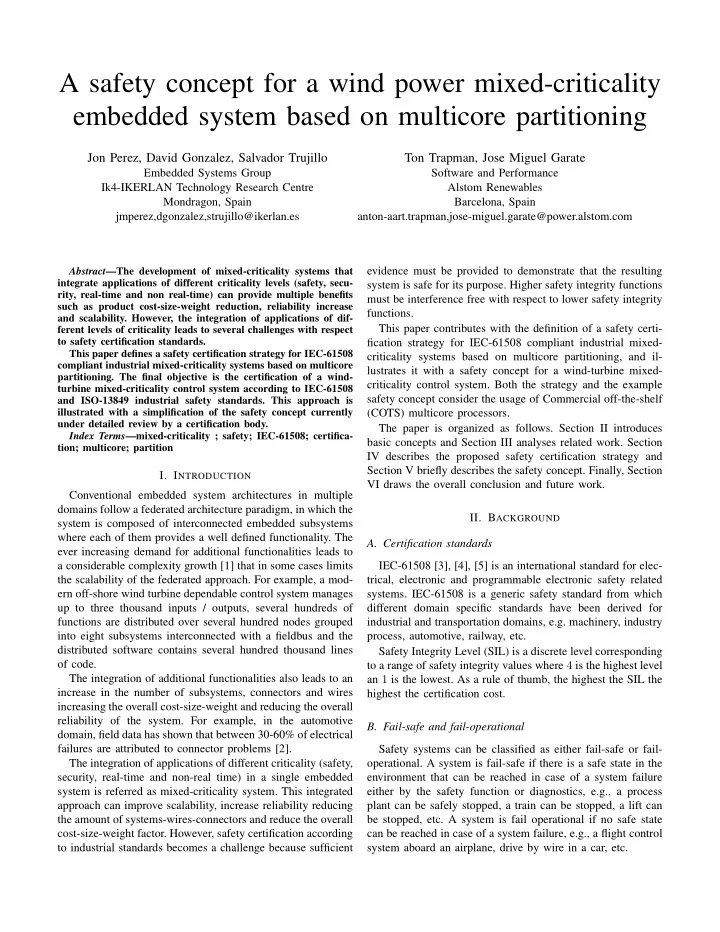

A safety concept for a wind power mixed-criticality embedded system based on multicore partitioning Jon Perez, David Gonzalez, Salvador Trujillo Ton Trapman, Jose Miguel Garate Embedded Systems Group Software and Performance Ik4-IKERLAN Technology Research Centre Alstom Renewables Mondragon, Spain Barcelona, Spain jmperez,dgonzalez,strujillo@ikerlan.es anton-aart.trapman,jose-miguel.garate@power.alstom.com evidence must be provided to demonstrate that the resulting Abstract —The development of mixed-criticality systems that integrate applications of different criticality levels (safety, secu- system is safe for its purpose. Higher safety integrity functions rity, real-time and non real-time) can provide multiple benefits must be interference free with respect to lower safety integrity such as product cost-size-weight reduction, reliability increase functions. and scalability. However, the integration of applications of dif- This paper contributes with the definition of a safety certi- ferent levels of criticality leads to several challenges with respect to safety certification standards. fication strategy for IEC-61508 compliant industrial mixed- This paper defines a safety certification strategy for IEC-61508 criticality systems based on multicore partitioning, and il- compliant industrial mixed-criticality systems based on multicore lustrates it with a safety concept for a wind-turbine mixed- partitioning. The final objective is the certification of a wind- criticality control system. Both the strategy and the example turbine mixed-criticality control system according to IEC-61508 safety concept consider the usage of Commercial off-the-shelf and ISO-13849 industrial safety standards. This approach is illustrated with a simplification of the safety concept currently (COTS) multicore processors. under detailed review by a certification body. The paper is organized as follows. Section II introduces Index Terms —mixed-criticality ; safety; IEC-61508; certifica- basic concepts and Section III analyses related work. Section tion; multicore; partition IV describes the proposed safety certification strategy and Section V briefly describes the safety concept. Finally, Section I. I NTRODUCTION VI draws the overall conclusion and future work. Conventional embedded system architectures in multiple domains follow a federated architecture paradigm, in which the II. B ACKGROUND system is composed of interconnected embedded subsystems where each of them provides a well defined functionality. The A. Certification standards ever increasing demand for additional functionalities leads to a considerable complexity growth [1] that in some cases limits IEC-61508 [3], [4], [5] is an international standard for elec- the scalability of the federated approach. For example, a mod- trical, electronic and programmable electronic safety related ern off-shore wind turbine dependable control system manages systems. IEC-61508 is a generic safety standard from which up to three thousand inputs / outputs, several hundreds of different domain specific standards have been derived for functions are distributed over several hundred nodes grouped industrial and transportation domains, e.g. machinery, industry into eight subsystems interconnected with a fieldbus and the process, automotive, railway, etc. distributed software contains several hundred thousand lines Safety Integrity Level (SIL) is a discrete level corresponding of code. to a range of safety integrity values where 4 is the highest level The integration of additional functionalities also leads to an an 1 is the lowest. As a rule of thumb, the highest the SIL the increase in the number of subsystems, connectors and wires highest the certification cost. increasing the overall cost-size-weight and reducing the overall reliability of the system. For example, in the automotive B. Fail-safe and fail-operational domain, field data has shown that between 30-60% of electrical failures are attributed to connector problems [2]. Safety systems can be classified as either fail-safe or fail- The integration of applications of different criticality (safety, operational. A system is fail-safe if there is a safe state in the security, real-time and non-real time) in a single embedded environment that can be reached in case of a system failure system is referred as mixed-criticality system. This integrated either by the safety function or diagnostics, e.g., a process approach can improve scalability, increase reliability reducing plant can be safely stopped, a train can be stopped, a lift can the amount of systems-wires-connectors and reduce the overall be stopped, etc. A system is fail operational if no safe state cost-size-weight factor. However, safety certification according can be reached in case of a system failure, e.g., a flight control to industrial standards becomes a challenge because sufficient system aboard an airplane, drive by wire in a car, etc.
Recommend
More recommend